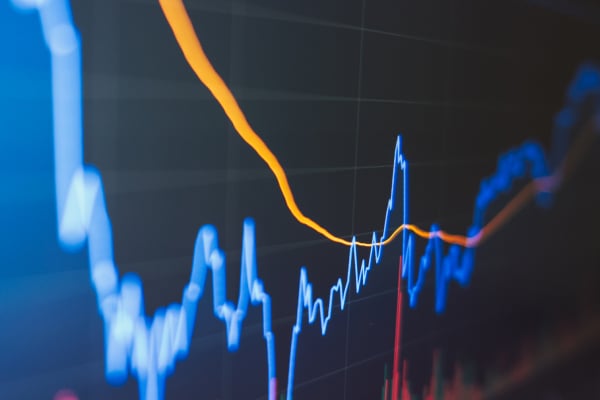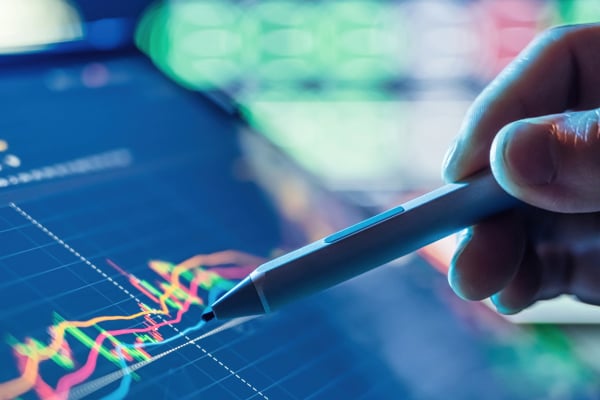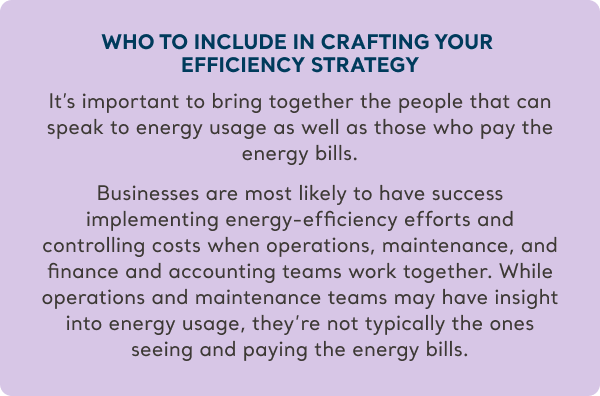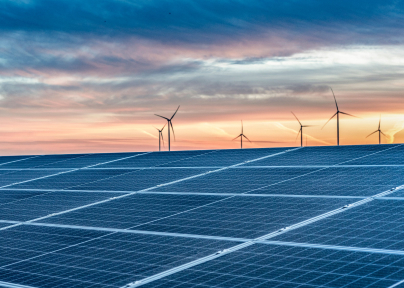Reducing energy consumption should be a business’s top priority.
As many organizations are feeling the impact of rising inflation, increasing labor costs, and other supply chain challenges, making any reduction can be an immensely helpful step toward better budget management. As for organizations with sustainability goals, they should consider efficiency efforts as the first step in their carbon-reduction journey.
CREATING AN EFFICIENCY ROADMAP
The enemy of sustainability? The status quo.
Businesses should consider the path toward sustainability as a series of steps, focusing first on reducing energy consumption and then on initiating sustainability measures that align with their goals. First up, enhancing energy efficiency anywhere it’s possible: replacing outdated equipment, retrofitting facilities with LED lighting, installing occupancy sensors, and more.
Like most strategic initiatives, improving efficiency takes time, as well as input from a few key players within a business. For some organizations, the question of where to start — and what changes will be most effective — can stall progress. The good news: Once you have a plan in place, energy efficiency practices can help you lower your consumption, and your bills, almost overnight. But you do need a plan to get there.
Here’s an easy-to-implement roadmap for getting started with energy efficiency for any business, big or small.

BRING THE RIGHT TEAM TO THE TABLE
To successfully benchmark your energy data, you need to consult with internal and external resources — and you must engage your frontline staff in the process. When the goal is to reduce consumption and waste, start not with consultants but with members of your own organization, notably the facilities and maintenance teams. While these employees will have insight into your energy usage, they're not typically the ones seeing and paying your energy bills. Organizations are most successful in implementing energy efficiency efforts and controlling their costs when operations, maintenance, and finance and accounting teams work together.
By bringing your internal experts into the process, you can establish a culture of sustainability: one in which all team members are connected to the overall goal of reducing waste and improving efficiencies. This model also supports the creation of strategies for reinvesting energy savings into future sustainability efforts.
Next, consider bringing on board an outside expert in managing and analyzing energy data. This can be tremendously helpful for organizations with small teams and few internal resources, as well as organizations hoping to meet significant milestones quickly.

BENCHMARK YOUR ENERGY DATA
After your initial energy review, a real-time monitoring program can be implemented to help identify and quantify opportunities for energy-efficiency improvements, benchmark usage before improvements, and verify the impact from the improvements. With an understanding of where your operations are today, you can determine when — and how — you're using energy and the impact on your energy costs.
Work with an expert who can help you review your bills and your hourly interval meter data. From here, with a better understanding of your usage patterns, you can develop a strategy with achievable and trackable goals.
UNDERSTAND YOUR ORGANIZATION'S ENERGY BILLS
About half of your energy bill is driven by your energy demand. Demand is a measurement of your largest interval of power used during the billing period, while consumption is a measurement of the total quantity of power you used during the billing period.
The demand you’re billed for is the peak amount of power used at any one time during your billing period — you aren’t charged for demand during the times when you’re using less than the peak amount. Energy-efficiency efforts typically help you save money by lowering the demand required to run your operations. So, being able to flex your energy load through efficiency solutions is one of the simplest ways to reduce your energy spend.
Reviewing a year’s worth of interval meter data can identify if the peak demand you’re being billed for happens often. Once you’re tracking your usage, an experienced supplier can help your business better understand when your energy usage is costing you the most — as there are peak times of the day during which energy is more expensive due to higher demand.

It’s important to recognize how the energy landscape in the U.S. is evolving and the impact of efficiency practices on our grid. We’re in the middle of a critical transition, shifting from a stage where the grid reacts to demand to one where generation fluctuates more — and end users will need to be more flexible. Needing less energy to run your business reduces not only your bill, but also removes demand from the grid.
HOW TO MEASURE YOUR ORGANIZATION'S ENERGY USE
Data is a great thing to have. But processing and managing data can be cumbersome and redundant — and a challenge that many organizations don't have the time or resources to take on.
Utility data is crucial for organizations seeking to demonstrate their commitment to energy-efficiency and carbon-reduction goals. Historically, this data has been collected and processed using spreadsheets or, in some cases, simply stored in filing cabinets. As expected, this isn't the most effective method — for collaboration or for goal setting.
Thanks in part to advancements in technology, the management of energy and sustainability data has evolved in significant ways in recent years. Software tools allow organizations to streamline their data management by providing:
- Automated utility bill management
- Real-time energy monitoring
- Program management services

This type of solution makes it possible to track, benchmark, analyze, and report on energy data, while reducing time-intensive processes.
Regardless of industry, organizations can benefit from visibility into their energy performance, as it can be useful toward finding ways to cut waste and save money. One challenge is that data may come from many different sources and in different formats, including:
- Accounting and finance teams
- Bill-pay systems
- Submeters
- Building automation systems (BAS)
An energy analytics platform can pull data from all these sources into one platform. And, for insight into factors that may impact your monthly bill, an energy analytics platform allows an organization to set audits and alerts on an as-needed basis.
For businesses that already understand their monthly utility bill data and are ready for more granular details, leveraging an energy analytics platform's real-time monitoring provides energy consumption in 15-minute intervals. This can help identify opportunities for immediate energy-efficiency improvements.

IN THIS REPORT, WE HIGHLIGHT THE KEY ENERGY TRENDS AND TOPICS MOST AFFECTING THE ENERGY INDUSTRY – AND CONSUMERS.
Dive into the next section below.




